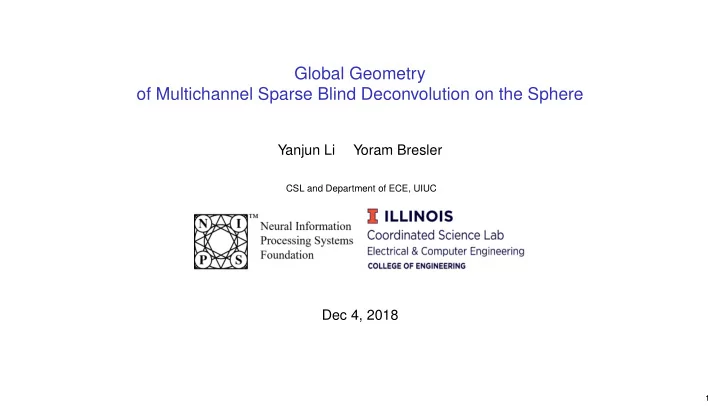

Global Geometry of Multichannel Sparse Blind Deconvolution on the Sphere Yanjun Li Yoram Bresler CSL and Department of ECE, UIUC Dec 4, 2018 1
Multichannel Sparse Blind Deconvolution (MSBD) Model: Given circular convolution: y i = x i ⊛ f , for i = 1 , 2 , . . . , N Solve for x i and f Assumptions: f ∈ R n : invertible signal x i ∈ R n : sparse filters Applications: opportunistic underwater acoustics reflection seismology functional MRI super-resolution fluorescence microscopy Open problem: Guaranteed algorithm for unconstrained f 2
Multichannel Sparse Blind Deconvolution (MSBD) Model: Given circular convolution: y i = x i ⊛ f , for i = 1 , 2 , . . . , N Solve for x i and f Assumptions: f ∈ R n : invertible signal x i ∈ R n : sparse filters Applications: opportunistic underwater acoustics reflection seismology functional MRI super-resolution fluorescence microscopy Open problem: Guaranteed algorithm for unconstrained f 2
Multichannel Sparse Blind Deconvolution (MSBD) Model: Given circular convolution: y i = x i ⊛ f , for i = 1 , 2 , . . . , N Solve for x i and f Assumptions: f ∈ R n : invertible signal x i ∈ R n : sparse filters Applications: opportunistic underwater acoustics reflection seismology functional MRI super-resolution fluorescence microscopy Open problem: Guaranteed algorithm for unconstrained f 2
Multichannel Sparse Blind Deconvolution (MSBD) Model: Given circular convolution: y i = x i ⊛ f , for i = 1 , 2 , . . . , N Solve for x i and f Assumptions: f ∈ R n : invertible signal x i ∈ R n : sparse filters Applications: opportunistic underwater acoustics reflection seismology functional MRI super-resolution fluorescence microscopy Open problem: Guaranteed algorithm for unconstrained f 2
Formulation Solving for inverse filter Find the inverse h of f N � 1 (P0) min � C y i h � 0 , s.t. h � = 0 . N h ∈ R n i =1 Solution: scaled & shifted Smooth formulation min. “sparsity” ℓ 1 norm ≈ max. “spiky” ℓ 4 norm N � h ∈ R n − 1 � C y i Rh � 4 min 4 , s.t. � h � = 1 . (P1) 4 N i =1 1 � N i =1 C ⊤ yi C yi ) − 1 / 2 Preconditioner R := ( θnN Solution: signed & shifted 3
Formulation Solving for inverse filter Find the inverse h of f N � 1 (P0) min � C y i h � 0 , s.t. h � = 0 . N h ∈ R n i =1 Solution: scaled & shifted Smooth formulation min. “sparsity” ℓ 1 norm ≈ max. “spiky” ℓ 4 norm N � h ∈ R n − 1 � C y i Rh � 4 min 4 , s.t. � h � = 1 . (P1) 4 N i =1 1 � N i =1 C ⊤ yi C yi ) − 1 / 2 Preconditioner R := ( θnN Solution: signed & shifted 3
Main Result Theorem (Geometric Analysis [ L. and Bresler, 2018] ) If { x i } N i =1 ⊂ R n : Bernoulli-Rademacher N � polylog( n ) Then w.h.p., local minima ⇐ ⇒ signed & shifted ground truth objective function: ◦ near local minima: strongly convex ◦ near local maxima & saddle points: negative curvature (strict saddle points) 4
Geometric Structure objective norm of gradient smallest curvature 5
First-Order Algorithm Optimize the sparsity promoting objective over the unit sphere � � Manifold gradient descent: h ( t +1) = P S n − 1 h ( t ) − γ � ∇ L ( h ( t ) ) ◦ gradient descent along the tangent space ◦ retraction (projection onto the sphere) Time complexity (per iteration): O ( Nn log n ) Theorem If geometric properties random initialization h (0) ∼ Uniform( S n − 1 ) fixed step size Then manifold gradient descent converges to a local minimum ( ≈ signed & shifted ground truth) a.s. achieves accuracy ρ after T � poly( n/ρ ) steps 6
Empirical Phase Transition Random f ∈ R n , Bernoulli-Rademacher x i ∈ R n Noise level: 20 dB Iteration number T = 100 , step size γ = 0 . 1 N vs. n N vs. θ N vs. κ (fix θ = 0 . 1 ) (fix n = 256 ) (fix n = 256 , θ = 0 . 1 ) 256 256 256 192 192 192 N N N 128 128 128 64 64 64 0.04 0.08 0.12 0.16 64 128 192 256 2 8 32 128 n θ κ Empirical success: ◦ N � nθ ◦ weak dependence on κ 7
Empirical Convergence Error Accuracy 1 0 . 8 1 � C f Rh ( t ) − e j � � C f Rh ( t ) � ∞ � C f Rh ( t ) � 0 . 6 0 . 5 0 . 4 0 . 2 0 0 50 100 0 50 100 t t 8
Application: SR Fluorescence Microscopy Time resolved images fluorophores = ⇒ sparse random activation = ⇒ random 9
Application: SR Fluorescence Microscopy true image true kernel nonblind deconvolution miscalibrated kernel blind deconvolution estimated kernel 10
Application: SR Fluorescence Microscopy blurry image true kernel nonblind deconvolution miscalibrated kernel blind deconvolution estimated kernel 10
Thank you! 11
Recommend
More recommend